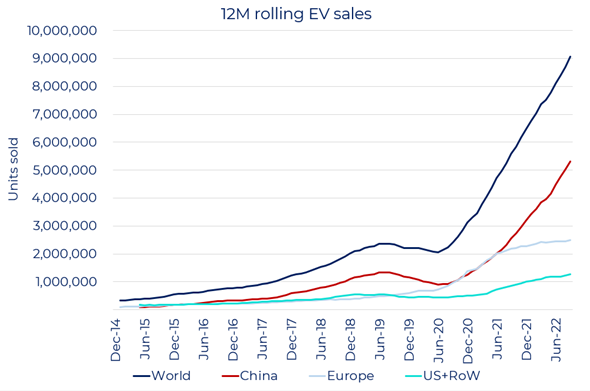 |
| Source: Guinness Global Investors |
A 17% share is significant. The upward curve signals that 2023 will likely exceed its predecessor by ~50%. Seventeen percent is important because it shows that EV sales have crossed the chasm of the technology adoption curve. The tipping point is at hand.
Technologies defuse into society in a predictable manner, following an adoption curve. As you can see above, the technology adoption curve splits the market up into 5 major groups based on their willingness to buy products in new categories. This curve applies to modern technologies such as smartphones, computers, and the internet but it also applies to older technologies such as telephones, electricity, and washing machines.
Early in a product's lifecycle, they are often cumbersome and difficult to use. This means only the most determined among us are willing to invest the time and mental energy needed to use these products. Slowly, improvements are made resulting in products that are easier to use and more affordable, so more people adopt them, moving further along the curve.
This generation of EVs started with the Chevy Volt and Nissan Leaf in December 2010. Back then EV ranges were short, prices were high, and charging infrastructure was scarce. Now, over a decade later and infrastructure has proliferated, ranges have increased, and prices have come down some. Increasing gasoline prices and government policies have also not hurt EV adoption. This has allowed EVs to move from the tech enthusiasts group into the early adopters group.
Collectively, tech enthusiasts and early adopters form the early market. Sadly, many products never break out of the early market 16% segment. They remain niche products and never move into the mainstream. This gap between the early market and the mainstream market is known as The Chasm. Crossing the chasm is the difference between having a small enthusiastic following or changing the way that society functions. Consider the difference between ham radio and smartphones; you can communicate with either one, but they are at very different places on the adoption curve.
Globally, EVs are on a course to cleanly jump the chasm with room to spare in 2023. This is something that hybrid vehicles have never been able to do. Entering the mainstream market means that economies of scale (see Wright's Law) begin to kick in, further reducing the costs and further increasing market adoption, creating positive feedback.
Conversely, this means the legacy product lines that are being displaced suffer shrinking market share. This drives up their costs as lines are shut down and fixed costs are amortized over a smaller number of units. This further makes the choice of the newer product more practical; allowing the next segment of the late majority to follow the early majority.
In 2014, we made the prediction that EVs would cross the chasm in the mid-2020s. It certainly appears that this will be the case for China next year and the rest of the world will soon be following. This will be fun to watch over the remainder of this decade and into the next.
fin

No comments:
Post a Comment